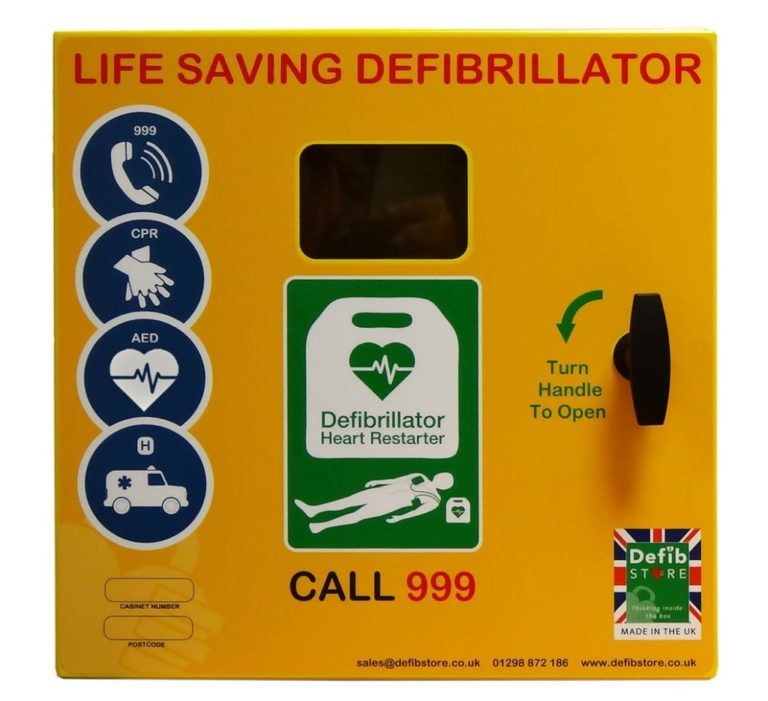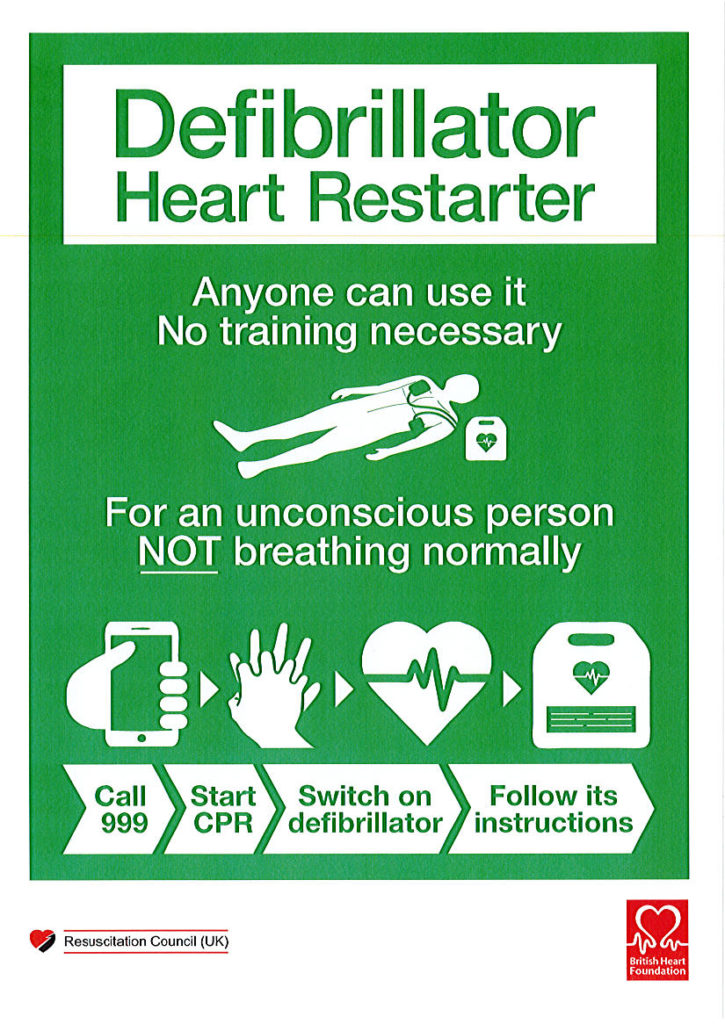We were successful in receiving a grant from the British Heart Foundation, as well as receiving kind donations from our Parishioners to purchase a ‘ Public Access defibrillator’ which is now kept in an unlocked heated, lit cabinet being accessible 24/7 in the exterior alcove, near to our notice board at St Joseph and the English Martyrs Catholic Church.
The Defibrillator has been registered with the East of England Ambulance and is security marked and identifiable.
The next free CPR Training and Defibrillator awareness sessions will be Saturday 12th October at 4pm in the WCC. There will be a sign up sheet in the Sacristy and spaces for 10 people at a time. We have already trained 17 Parishioners this week.. with more training sessions to follow
Please take a few minutes to familiarise yourself, your family members and friends on how to use a Defibrillator – it is very easy !. The machine gives clear spoken instructions – all you have to do is follow them – and it won’t shock someone unless they need it! Please also take some time to learn how to perform CPR. Watch the 2 British Heart Foundation videos below…
INSTRUCTIONS
If you come across someone who is unconscious, unresponsive, not breathing or not breathing normally, they’re in cardiac arrest. The most important thing is to call 999 and start CPR to keep the blood flowing to the brain and around the body. After a cardiac arrest, every minute without CPR and defibrillation reduces someone’s chance of survival by 10 per cent.
If you’re on your own, don’t interrupt the CPR to go and get a defibrillator. If it’s possible, send someone else to find one. When you call 999, the operator can tell you if there’s a public access defibrillator nearby.
To learn how to perform CPR, follow these simple steps:
Step 1: Shake and shout
Step 2: Check for normal breathing
Step 3: Call 999
Step 4: Give 30 chest compressions
Step 5: Give two rescue breaths
Step 6: Repeat until an ambulance arrives
CPR steps
To learn more about performing CPR in an emergency, read the rest of this page and scroll down for our CPR training video.
Step 1: Shake and shout
If you come across someone who is unconscious, always check for danger and look for risks before you start helping.
Check for a response – gently shake the person’s shoulders and ask loudly ‘are you alright?’
Shout for help – if someone is nearby, ask them to stay as you might need them. If you are alone, shout loudly to attract attention, but don’t leave the person.
Step 2: Check for normal breathing
Someone having a cardiac arrest won’t be breathing, or won’t be breathing normally. They also won’t be conscious.
Keeping their head back, check if the person is breathing normally by looking for:
regular chest movements
listening for breathing
feeling for breath on your cheek.
Look, listen and feel for no more than 10 seconds. Don’t confuse gasps with normal breathing. If you’re not sure if their breathing is normal, act as if it’s not normal.
If you’re sure the person is breathing normally, then put them in the recovery position and call 999.
If breathing isn’t normal, open their airway. To do this, place one hand on the person’s forehead, gently tilt their head back, then lift their chin using two fingers of your other hand under their chin – when you do this you open their airway.
Step 3: Call 999
If the person is not breathing or not breathing normally:
ask someone to call 999 immediately and ask for an ambulance
ask someone for a public access defibrillator (PAD).
If you can’t find anyone to help, call 999 before you start CPR.
Step 4: Give 30 chest compressions
Kneel next to the person.
Place the heel of one hand in the centre of their chest. Place your other hand on top of the first. Interlock your fingers.
With straight arms, use the heel of your hand to push the breastbone down firmly and smoothly, so that the chest is pressed down between 5–6 cm, and release.
Do this at a rate of 100 to 120 chest compressions per minute – that’s around 2 per second
Step 5: Give two rescue breaths
Open the airway again by tilting the head back and lifting the chin. Pinch the soft part of the person’s nose closed.
Take a normal breath, make a seal around their mouth and breathe out steadily.
The person’s chest should rise and fall. Keeping the person’s head back and the chin lifted, take your mouth away, take another normal breath, and give a second rescue breath. The two breaths should take no longer than five seconds.
Step 6: Repeat until an ambulance arrives
Repeat 30 compressions and two rescue breaths.
If you’d rather not give rescue breaths then call 999 and deliver hands-only CPR. That’s better than doing nothing.
Keep going until professional help arrives and takes over, or the person starts to show signs of regaining consciousness, such as coughing, opening their eyes, speaking, or breathing normally.
If you’re feeling tired, and there’s someone nearby to help, instruct them to continue.
British Heart Foundation CPR demonstration video
To use a defibrillator, follow these simple steps:
Step 1: Turn the defibrillator on by pressing the green button and follow its instructions.
Step 2: Peel off the sticky pads and attach them to the patient’s skin, one on each side of the chest, as shown in the picture on the defibrillator.
Step 3: Once the pads have been attached, stop CPR and don’t touch the patient. The defibrillator will then analyse the patient’s heart rhythm.
Step 4: The defibrillator will assess whether a shock is needed and if so, it will tell you to press the shock button. An automatic defibrillator will shock the patient without prompt. Do not touch the patient while they are being shocked.
Step 5: The defibrillator will tell you when the shock has been delivered and whether you need to continue CPR.
Step 6: Continue with chest compressions and rescue breaths until the patient shows signs of life or the defibrillator tells you to stop so it can analyse the heartbeat again.
British Heart Foundation – How to use a defibrillator demonstration Video

